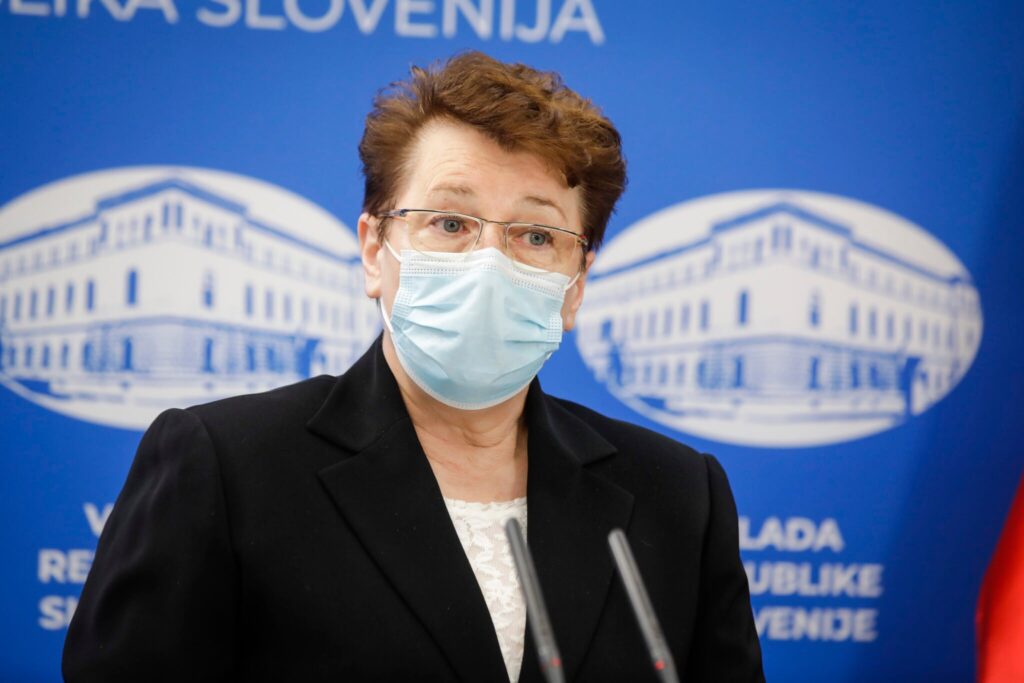The press conference on the current situation regarding COVID-19 was attended by State Secretary at the Ministry of Health Alenka Forte and Mojca Kirbiš, Headteacher at Rado Robič Limbuš Primary School.
Some 1,428 PCR-tests were performed on Sunday, of which 247 were positive, which is 17.3 per cent, and 8,551 rapid tests were also done. Some 584 patients were hospitalised yesterday, which is 18 more than on Saturday, of whom 104 require intensive care. This number is quite lower than that on Friday, when 623 patients were hospitalised. Eight patients have died, none in retirement homes.
The 7-day incidence rate is 744, i.e. four fewer than on Saturday. The number of active COVID-19 cases has been reducing for some time now across the country. There were 11,032 cases registered yesterday.
Exit strategy for hospitals to reduce the number of hospitalised COVID-19 patients
Alenka Forte presented the exit strategy of hospitals with regard to decreasing the number of COVID-19 patients in hospitals. We are currently in the first phase as the number of hospitalised patients has dropped below 700. As a result, the capacity of hospitals in regard to COVID-19 wards has reduced by 10 per cent for all bed capacities intended for COVID-19 patients, except in Golnik Hospital where the percentage is 15. Topolšica and Sežana hospitals are no longer COVID-19 hospitals and have begun fully implementing their regular programmes.
The second phase will commence when the number of currently hospitalised patients (584) is brought below 500. At which point, Ptuj, Slovenj Gradec, Trbovlje, Brežice and Izola hospitals will no longer be considered COVID-19 hospitals and will start executing their regular programmes.
The same will apply to Jesenice General Hospital, which is in a special situation due to fire safety and energy rehabilitation and the construction of a new intensive care unit. Its COVID-19 intensive care unit will be closed down and all newly discovered COVID-19 patients will be referred to Golnik or Ljubljana University Medical Centre.
All hospitals will preserve grey zones in emergency centres where patients suspected of having COVID-19 will be isolated. If a patient tests positive, they will be referred to the most suitable and closest hospital for further treatment in accordance with the exit strategy.
The health system will move to the third phase once the number of hospitalised COVID-19 patients drops below 250. Ljubljana University Medical Centre, Maribor University Medical Centre, Golnik University Clinic and Celje, Novo mesto and Nova Gorica general hospitals will further operate as COVID-19 hospitals.
In the fourth phase, when the number of hospitalised COVID-19 patients is below 100, the COVID-19 hospitals will be Ljubljana University Medical Centre, Maribor University Medical Centre and Golnik University Clinic. If the number of COVID-19 patients further decreases, beds at the intensive unit for COVID-19 patients at Golnik will also be cancelled.
The health system will thus gradually start implementing its regular programme. With their preventive behaviour and consistent observance of the measures, every person can contribute to a prompt return to the normal functioning of the healthcare system. In addition to managing COVID-19 patients, the hospitals succeeded in carrying out, on average, 75 per cent of their regular programmes.
With regard to other topical issues relating to healthcare, Forte highlighted that SOČA University Rehabilitation Institute records an exceptionally high, as much as 85-per cent, immunisation rate of health professionals. Service providers working in the field do not report a lack of tests. An assessment in the decline of the epidemic in March is difficult to make due to winter school holidays taking place last week and this. Vaccinations within the critical infrastructure have not yet started, except for soldiers going on assignments abroad. Not many certificates will be issued for individuals with whom COVID-19 was confirmed only by their general practitioner in an outpatient clinic. The issue of such certificates is free of charge.
Primary school pupils and secondary school students in the eastern part of Slovenia return to schools
Kirbiš emphasised that they prepared well for the re-opening of schools, including by testing. The teachers were tested during the weekend and from now on testing will be carried out once a week at individual schools by the mobile units of Maribor Community Health Centre. When speaking to pupils from sixth to ninth grade, it was possible to ascertain that they would prefer to continue with distance learning because they were able to adjust their schedule and biorhythm at home. The school asked the parents of fourth and fifth graders to provide alternate care arrangements so the children would not remain in school after lessons. The biggest challenges are the safe implementation of lunch breaks and the organisation of elective subject lessons in higher grades.
Source: gov.si


